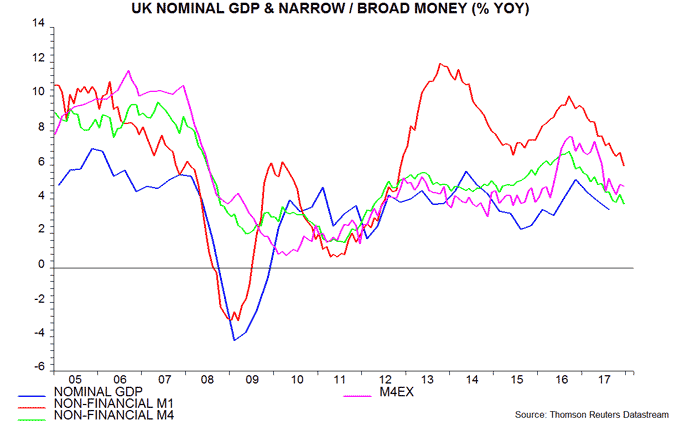UK MPC hawkish shift at odds with money trends
Last week’s UK Inflation Report signalled that the MPC intends to raise rates again in May if the economy evolves in line with its forecast. Monetary trends suggest that the Committee should proceed with caution.
The MPC’s new-found hawkishness partly reflects its repeated underestimation of inflation outturns. January consumer price inflation remained at 3.0%, in line with the latest Bank staff estimate but well above a projection of 2.6% for the first quarter of 2018 in the November Inflation Report. The MPC expects inflation to fall back to 2.4% by the fourth quarter of 2018. It may continue to be disappointed – on plausible assumptions, the forecast for late 2018 here is 2.6-2.7%.
Current and near-term high inflation, however, is a consequence of past policy laxity relative to monetary and economic conditions. Belated remedial action risks compounding the error.
The February Inflation Report, as usual, contained no monetary analysis. The MPC’s difficulties, on the view here, stem from its neglect of monetary trends. A key mistake was to ease policy in August 2016 when money growth was high and rising. Annual expansion of the Bank’s broad M4ex aggregate was 5.9% in June 2016 (available to the MPC in August), the highest since 2008, with the narrow non-financial M1 measure growing by 9.2% – see chart.
Monetary trends, that is, signalled that the economy did not require post-EU-referendum support. The MPC’s easing decision magnified the fall in sterling associated with the referendum result, thereby contributing to the current inflation overshoot.
Annual money growth, however, peaked in late 2016 and trended lower during 2017. December numbers released in late January – the first to reflect a full month at the higher level of Bank rate – showed a further significant step down. Annual expansion of non-financial broad and narrow money is the lowest since 2012. The monetary slowdown has been reflected in a moderation of nominal GDP growth.
Monetary trends are not weak enough to suggest imminent economic danger and / or an eventual inflation undershoot. They question, however, the urgency of policy tightening. The MPC, on the view here, should wait for a stabilisation or recovery in money growth before hiking again.

Reader Comments